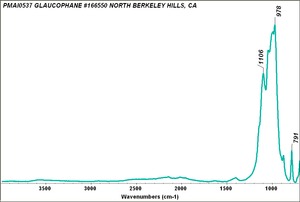Difference between revisions of "Glaucophane"
Jump to navigation
Jump to search
| (2 intermediate revisions by 2 users not shown) | |||
| Line 7: | Line 7: | ||
blue schist; blueschist | blue schist; blueschist | ||
| − | [[[SliderGallery rightalign|GLAUCOPHANE PMA.TIF~FTIR ( | + | [[[SliderGallery rightalign|GLAUCOPHANE PMA.TIF~FTIR (PMA)]]] |
| − | == | + | == Physical and Chemical Properties == |
| − | Crystal system=monoclinic (fibrous, granular, or massive) Cleavage=good in two directions (56 and 124 | + | * Crystal system=monoclinic (fibrous, granular, or massive) |
| + | * Cleavage=good in two directions (56 and 124 degrees). | ||
| + | * Fracture=brittle, conchoidal | ||
| + | * Luster=vitreous to pearly | ||
| + | * Streak=grayish blue | ||
| + | * Nonfluorescent | ||
| + | * Pleochroic=from yellow to violet to blue-green | ||
| + | * Composition = Na2(Mg3Al2)Si8O22(OH)2 | ||
| + | * Mohs Hardness = 6.0-6.5 | ||
| + | * Density = 3.00-3.15 | ||
| − | + | ==Resources and Citations== | |
| − | |||
| − | |||
| − | |||
| − | |||
| − | |||
| − | |||
| − | |||
| − | |||
| − | |||
| − | |||
| − | == | + | * WebMinerals at http://webmineral.com/data/Glaucophane.shtml (Accessed Jan. 6, 2006) hardness=6.0-6.5, density =3-3.15 |
| − | + | * McGraw-Hill Access Science at http://www.accessscience.com/Encyclopedia/2/29/Est_291100_frameset.html?doi (Accessed Jan. 6, 2006) | |
| − | + | * Geology.about.com at http://geology.about.com/library/bl/images/blglaucophane.htm (Accessed Jan. 6, 2006) | |
| − | * | + | * Mineral Galleries at http://www.galleries.com/minerals/silicate/glaucoph/glaucoph.htm (Accessed Jan. 6, 2006) hardness=5-6, density = 3-3.2 |
| − | |||
| − | |||
| − | |||
| − | |||
| − | |||
| − | |||
[[Category:Materials database]] | [[Category:Materials database]] | ||
Latest revision as of 12:38, 27 August 2022
Description
A double chain silicate (amphibole) type mineral that typically occurs as blue-gray sheets. Glaucophane is found in dense metamorphic rocks, such as basalts. Significant deposits have been discovered in Greece (Cyclades Islands, Syra Island), Italy (St. Marcel, Val d'Aosta, Piollore), Wales (Anglesey), Australia, Japan, and the US (Kodiak Islands, California). The pleochroic mineral changes colors from yellow to violet to blue when a thin section is viewed in plane polarized light.
Synonyms and Related Terms
blue schist; blueschist
Physical and Chemical Properties
- Crystal system=monoclinic (fibrous, granular, or massive)
- Cleavage=good in two directions (56 and 124 degrees).
- Fracture=brittle, conchoidal
- Luster=vitreous to pearly
- Streak=grayish blue
- Nonfluorescent
- Pleochroic=from yellow to violet to blue-green
- Composition = Na2(Mg3Al2)Si8O22(OH)2
- Mohs Hardness = 6.0-6.5
- Density = 3.00-3.15
Resources and Citations
- WebMinerals at http://webmineral.com/data/Glaucophane.shtml (Accessed Jan. 6, 2006) hardness=6.0-6.5, density =3-3.15
- McGraw-Hill Access Science at http://www.accessscience.com/Encyclopedia/2/29/Est_291100_frameset.html?doi (Accessed Jan. 6, 2006)
- Geology.about.com at http://geology.about.com/library/bl/images/blglaucophane.htm (Accessed Jan. 6, 2006)
- Mineral Galleries at http://www.galleries.com/minerals/silicate/glaucoph/glaucoph.htm (Accessed Jan. 6, 2006) hardness=5-6, density = 3-3.2
